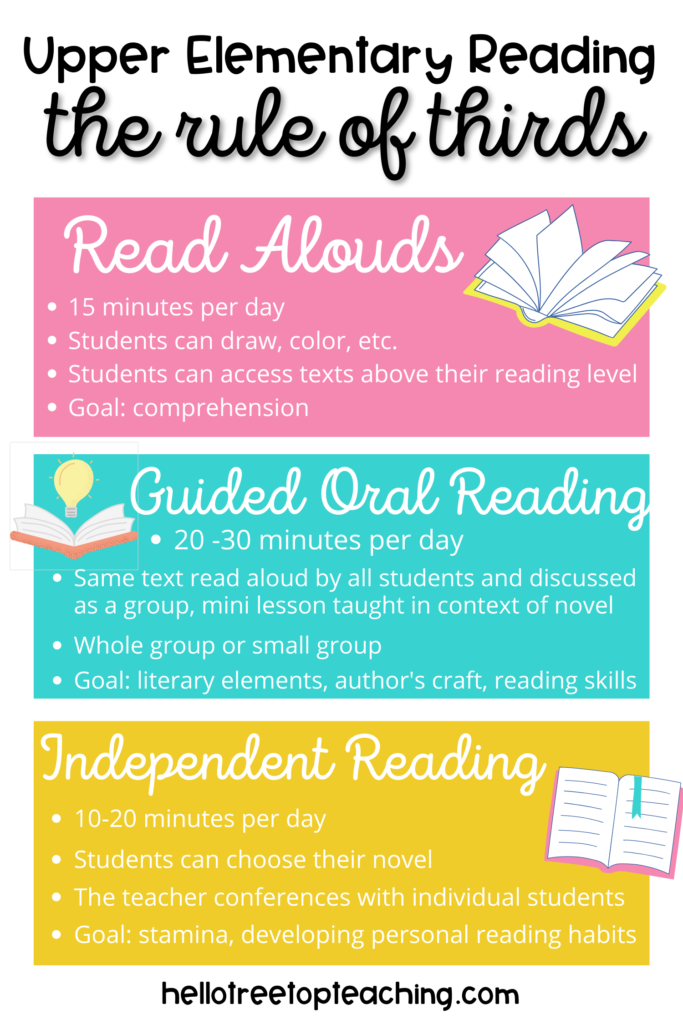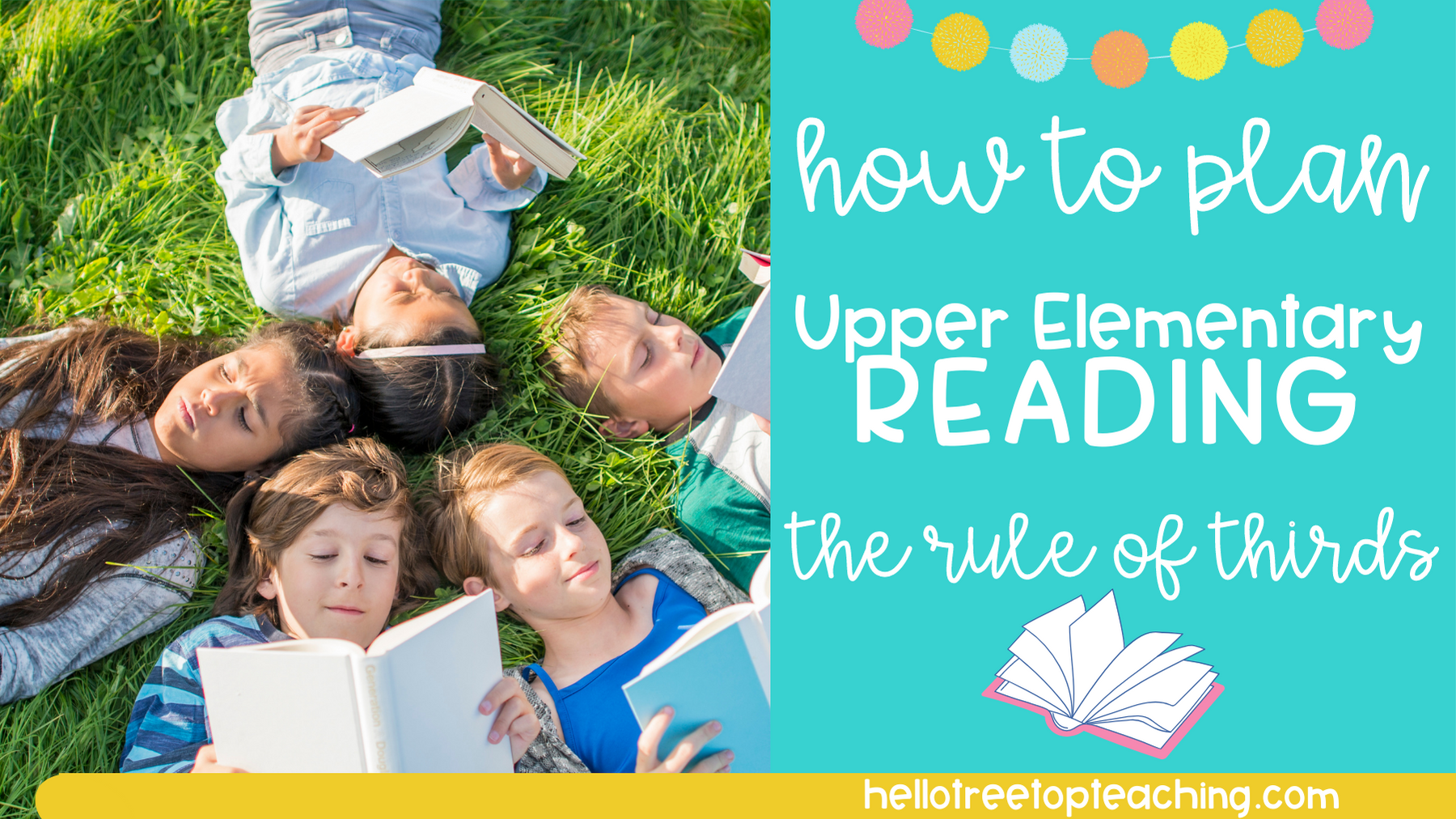In my upper elementary classroom, I structure my reading time using the rule of thirds. One-third of our class time is for read-alouds, one-third is for shared group reading, and one-third is for independent reading.

Why Use the Rule of Thirds?
At first, I’ll admit, I didn’t think that this was going to work. I thought that reading three different books at the same time would confuse students. I thought there was no way there would be enough time in the day to do all three of these. But within only the first month of putting this into practice, I realized I was terribly wrong.
There are so many goals that we have for our students revolving around reading. So it makes sense that we would need multiple strategies to achieve them all. We are looking for balance and authentic reading within our reading block. And the hard truth is print-and-go reading passages aren’t going to it. Our students, even in the upper elementary classroom, need to experience books- cover to cover- as often as possible.
Each of these sections of my reading time serve a different purpose. By isolating the type of reading, I allow students to intentionally focus on developing a certain skill. During the read aloud, students are practicing their comprehension. In guided oral reading, we share a novel as a class and discuss several different literary elements and the author’s craft. During independent reading, students are building a love of reading and personal preference to create life-long readers.
Reading Aloud to Students
Reading aloud to students allows them to focus on the skill of comprehension. When our students read, we want them to see moving pictures in their mind. This is a tricky skill to teach; it has to be developed through practice. One of the best ways that I have found to practice this skill of building pictures in the minds of students is reading aloud.
Even though I teach upper elementary, every year I have students who are still struggling to decode words. When I read aloud, it levels the playing field for all readers at all different abilities. Every student can access the story because the decoding part of reading is removed. Struggling students often say that they don’t like reading; but this just isn’t the case. When I read aloud to students and they jump into a story, they find that they really love stories. They are newly motivated to practice their reading independently, so they can experience more of these types of stories.

How does the read aloud look in a given day?
I fit in a read-aloud time for 15 minutes every single day after recess. This is a commitment as far as giving up the classroom time. After just one year of really dedicating myself to this, I can say with certainty that the results were worth every minute that I gave up. By far it was the most fruitful portion of our reading time.
Over the course of this past year we read eight full novels aloud as a class. And because we shared this reading experience, we were able to have incredible group discussions revolving around characters, themes, the craft of the author, etc.

Guided Oral Reading
We spend the second third of our reading time reading a novel aloud together as a group. It allows us to discuss things like voice inflection, pronunciation, pacing, etc. It teaches them to attune to the art and the details of reading a novel. My focus during this time is not comprehension or stamina, it is about teaching them literary components of a novel that will hopefully in turn increase their comprehension, stamina, and joy from reading.
This also gives us the opportunity to have these shared literature experiences where we can discuss the elements of the story as well as the students’ thoughts and connections. We practice defining words that are unknown in the context of sentences. And because we’re reading this novel all together, the students can demonstrate for one another what this process looks like.
How does guided oral reading look in a given day?
You could certainly do this in small groups, but I would highly suggest your entire class read the same novel. This builds that classroom culture and community where all students share experiences. We spend 20 minutes of our literature class time reading together. This does mean that you will need to locate a class set. Since my school uses novels for all reading instruction, we have endless options. But this may not be the case for you.
I stop periodically and have students notice different things. I may ask them to notice the authors use of adjectives and choose a few to add to their own adjective list for writing. (Here’s a great post on integrating parts of speech in reading and writing). I may ask them about the characters thoughts, words, emotions. I may ask for a prediction or have them note the use of figurative language. The possibilities are endless.
I choose novels that align with our period of history for the year, classics that I know they will love but may not pick-up on their own, or stories that will shape their hearts and minds as they mature and grow. My goal here is not entertainment or enjoyment (although I do hope my students enjoy them); my goal is to teach them and demonstrate for them quality literature, and for them to notice the craft of good authors.

Independent Reading
For the independent reading time my goal is to help students learn to find novels that they like, build their reading stamina, and to encourage them to read across a variety of genres. Unlike my goals for comprehension and appreciation of literary art form with the other thirds, with independent reading I want them to find the joy in getting lost in a story.
How does independent reading look in a given day?
Usually the students have between 10 to 20 minutes per day of independent reading time. You can fit this in as a morning work assignment, after specials, after lunch, or as a set time somewhere in your schedule.
During the independent reading time I meet with students to see their progress and thoughts on the novel that they’ve chosen to read independently. I only meet with 3-5 students per day. These conferences are very short and really just a check in with them. Once a week, the students will write me a one-page reflection on their independent reading book, giving me another opportunity to assess their progress.

Check Some of My Favorite Books for Upper Elementary
Some of the links on this site are affiliate links. This means that at zero cost to you, I will earn an affiliate commission if you click through the link and finalize the purchase.
This system of breaking our reading into thirds ensures that I am guiding and practicing all of the skills needed to be lifelong-readers within my literature time. If I were to just use one of these parts, I feel that their understanding of reading and literature as a whole would be incomplete.


